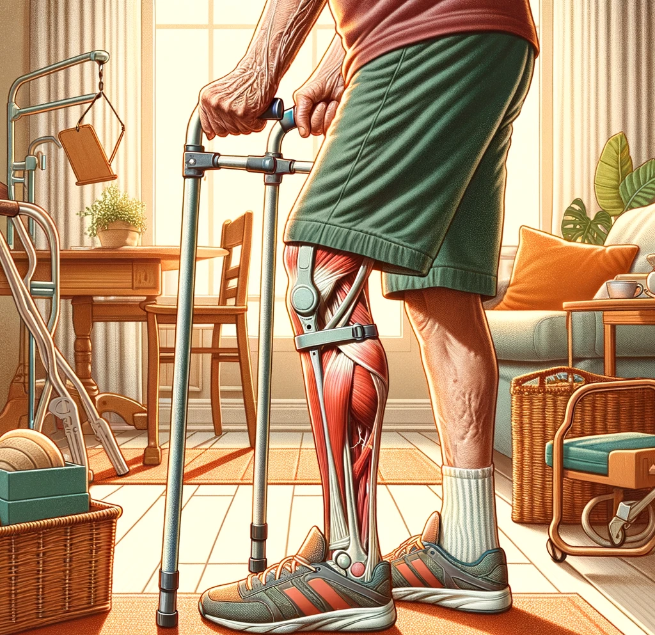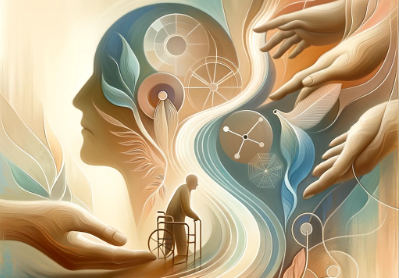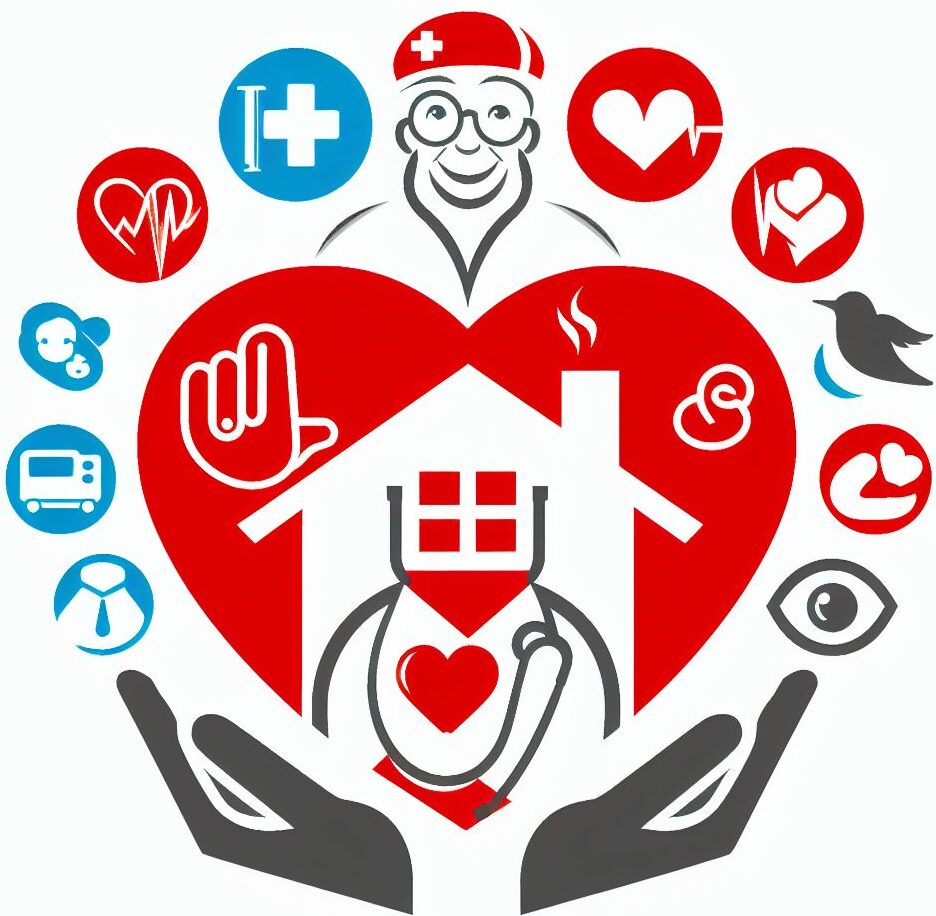Charcot-Marie-Tooth disease (CMT) is a hereditary challenge affecting the peripheral nervous system. It presents a spectrum of symptoms impacting the elderly.
The progression and manifestation of CMT in older adults pose unique difficulties. Therefore, it necessitates a nuanced understanding of its nature, symptomatology, and the requisite specialized care approaches.
This article explores the facets of CMT, highlighting its implications for the elderly. Additionally, it outlines the comprehensive care strategies essential for managing this condition effectively.

Charcot-Marie-Tooth Disease | An Introduction
Definition and Explanation of Charcot-Marie-Tooth (CMT) Disease
CMT is a cluster of inherited peripheral neuropathies, characterized by a progressive degeneration of the muscles and loss of sensation, primarily in the feet and hands.
This degeneration results from defects in the nerve cells that impair the transmission of electrical signals. These are necessary for muscle movement and sensory information processing.
The disease’s genetic basis lies in various mutations that affect the nerve’s structure or function, leading to the symptoms associated with CMT.
Different Types of CMT and Their Genetic Origins
The complexity of CMT is reflected in its classification into several types, each tied to specific genetic mutations.
For example, Type 1 CMT, the most prevalent form, is linked to mutations that damage the myelin sheath, the protective covering of the nerve fibers. This damage slows down signal transmission.
In contrast, Type 2 CMT affects the nerve axon itself, which directly impacts the strength and speed of these signals. This genetic diversity underscores the personalized nature of CMT symptoms and their progression.
Statistics on CMT Prevalence Among the Elderly
Although CMT can manifest at any age, its prevalence in the elderly population is notable. As such, symptoms either emerge or intensify in later life.
The exact prevalence rates vary, but the progressive nature of CMT means that older adults are increasingly likely to experience its symptoms. Hence, this demographic shift highlights the importance of recognizing and addressing CMT in geriatric care settings.
Recognizing the Symptoms of CMT in the Elderly
Common Symptoms and How They Differ from Typical Age-Related Issues
The hallmark symptoms of CMT in the elderly can easily be mistaken for normal aging. These include:
- Muscle weakness.
- Atrophy
- Foot deformities.
- And sensory loss.
However, the progression of these symptoms, coupled with their specific patterns (e.g., the “stork leg” appearance due to muscle wasting in the lower legs), helps differentiate CMT from typical age-related changes.
These symptoms are attributable to the underlying nerve damage, which is distinct from the wear and tear associated with aging.
Late-Onset CMT and Its Unique Challenges
Late-onset CMT can be particularly challenging to diagnose and manage. Moreover, its symptoms often arise suddenly and may progress more rapidly than those appearing earlier in life.
This sudden change can be distressing for elderly patients and their families. Additionally, it complicates existing age-related health issues and necessitates swift adjustments in care and support strategies.
The Impact of Progressive Nerve Damage on Daily Activities
The progressive nerve damage in CMT gradually impairs the ability to perform daily activities, from walking and balancing to tasks requiring fine motor skills.
As these abilities decline, elderly patients may face increased difficulties with mobility, personal care, and engaging in social activities, significantly impacting their quality of life and independence.
The Particular Challenges CMT Poses to the Elderly
How CMT Exacerbates Common Age-Related Health Concerns
CMT’s progression in the elderly can amplify the effects of common age-related health issues, such as osteoporosis, arthritis, and the general risk of falls.
The muscle weakness and sensory loss associated with CMT increase the difficulty of managing these conditions. Hence, elderly patients are more susceptible to injuries and complications.
Mobility and Independence Concerns for Elderly CMT Patients
Moreover, maintaining mobility and independence is a significant concern for elderly CMT patients. The disease’s impact on muscle strength, coordination, and balance can lead to a reliance on assistive devices and, in some cases, caregiver support for basic activities.
This dependency can affect the psychological well-being of elderly patients, who may struggle with the loss of autonomy and the need to adapt to new limitations.
The Psychological Effects of Living with Chronic Illness in Old Age:
The chronic nature of CMT, coupled with its late-onset manifestation, can have profound psychological effects on elderly patients.
The adjustment to living with a progressive, incurable illness often involves coping with anxiety, depression, and grief over lost functions and independence. Therefore, addressing these psychological aspects is crucial for holistic care and support for elderly CMT patients.
Tailoring Care for Elderly CMT Patients
Adapting the Home Environment for Safety and Accessibility
Creating a safe and accessible home environment is paramount for elderly CMT patients. This helps to maintain independence and prevent falls, which are a significant risk due to muscle weakness and balance issues.
Adaptations can range from simple modifications to more extensive home renovations:
- Removing Trip Hazards: Securing or removing rugs, ensuring cables are tucked away, and maintaining a clutter-free floor can significantly reduce the risk of falls.
- Bathroom Safety: Installing grab bars in the shower and near the toilet, along with a shower chair or bench, can aid in safe bathing and toileting. Non-slip mats in the bathroom are also crucial.
- Stair Safety: Adding handrails on both sides of staircases or considering stairlifts for those with severe mobility issues can facilitate safe access between floors.
- Lighting: Improving lighting throughout the home, including night lights in hallways and bathrooms, can help prevent falls during nighttime movements.
- Flooring: Replacing flooring with non-slip options or ensuring carpets are securely fixed to the floor can provide safer surfaces for mobility.
Specialized Care Needs: Physical and Occupational Therapy, and Assistive Devices
Specialized care for elderly CMT patients focuses on maximizing mobility, maintaining independence, and managing symptoms:
- Physical Therapy (PT): Tailored exercises can help maintain muscle strength and flexibility, improve balance, and reduce pain. PT is essential in slowing the progression of muscle weakness and atrophy.
- Occupational Therapy (OT): OT focuses on enhancing daily living skills, from dressing and grooming to cooking and eating. Therapists can recommend adaptive tools and strategies to compensate for hand weakness and fine motor skill challenges.
- Assistive Devices: Various devices can aid in mobility and daily activities, including orthotic devices (such as ankle-foot orthoses) to improve walking, adaptive utensils for eating, and voice-activated technologies for those with hand dexterity issues.
Support Networks and Resources for Patients and Caregivers
Navigating CMT, especially in later life, can be challenging for both patients and their caregivers. Therefore, access to a supportive community and resources can make a significant difference:

- Support Groups: Joining CMT-specific support groups, whether in-person or online, can provide emotional support, practical advice, and a sense of community.
- Educational Resources: Organizations dedicated to CMT often offer educational materials, webinars, and workshops that help patients and caregivers understand the disease, current research, and management strategies.
- Caregiver Support: Caregivers also need support, including respite care options, counseling, and practical resources to help them manage their roles effectively and sustainably.
Tailoring care and support for elderly CMT patients requires a holistic approach that addresses physical, emotional, and environmental needs.
By adapting the home environment, ensuring access to specialized care, and leveraging support networks, patients and caregivers can navigate the challenges of CMT with confidence and dignity.
CMT Questions | Share Your Thoughts
Please share your answers to the following questions:
- Personal Experiences: Have you or someone you know been affected by Charcot-Marie-Tooth disease? We would love to hear about your journey. What challenges have you faced, and how have you overcome them?
- Management Strategies: What management strategies or treatments have been most effective for you or your loved one living with CMT? Are there any tips or resources you can recommend to others in the CMT community?
- Support Systems: How has connecting with others affected by CMT helped you? Do you have any advice for finding support groups or communities for those newly diagnosed?
- Research and Developments: What are your thoughts on the current research and developments in treatments for CMT? Are there any particular advancements or studies that you find promising or are closely following?
- Daily Living Adjustments: What adjustments have you made in your daily life or home to better accommodate living with CMT? Do you have any advice for others on making life with CMT more manageable?
- Raising Awareness: In your opinion, what is the most important thing people should know about CMT? How can we work together to raise awareness and understanding of this condition?
- Future Hopes: What are your hopes for the future in terms of treatment or management of CMT? Is there something specific you’re hoping for, such as advancements in gene therapy or more accessible support resources?
Your engagement will assist others confronting this condition or caring for someone who is.
Conclusion | Charcot-Marie-Tooth Disease
Charcot-Marie-Tooth disease presents significant challenges for the elderly, affecting their mobility, independence, and psychological well-being.
So, understanding the unique symptoms and needs of elderly CMT patients is crucial for providing effective care and support. Tailoring interventions to enhance safety, mobility, and quality of life can help manage the symptoms of CMT and improve the overall well-being of elderly patients.
Individuals with this condition typically have a normal life expectancy. For instance, it usually doesn’t affect vital organs or the central nervous system, which means it generally doesn’t impact an individual’s lifespan.
However, the complications associated with the disease, such as injuries from falls or respiratory weakness in severe cases, can impact overall health and quality of life.
With proper management, including physical therapy, use of orthotic devices, and sometimes surgery to manage symptoms and prevent complications, individuals with CMT can lead active and fulfilling lives.
As research continues to advance, it is hoped that more effective treatments will become available, offering hope for those affected by this challenging condition.
It is my hope that “Charcot-Marie-Tooth Disease Symptoms | In the Elderly” has been informative and helpful in some way.
Please feel free to share your thoughts, questions, or comments below. I’d love to hear from you and will be happy to respond.
Veron | Entrepreneur | The Way 4WordEnterprises
